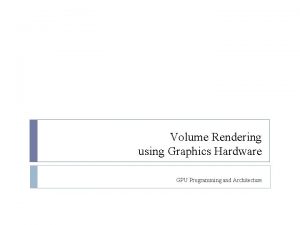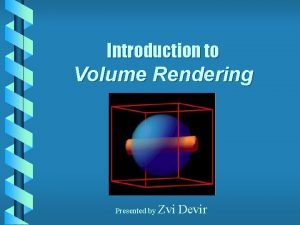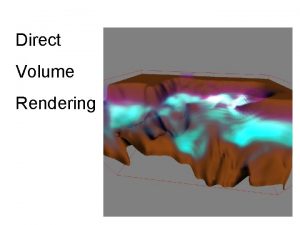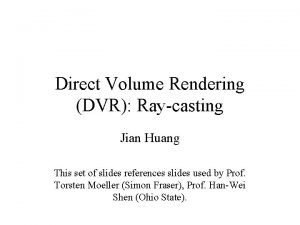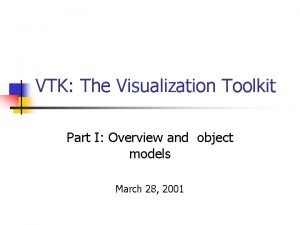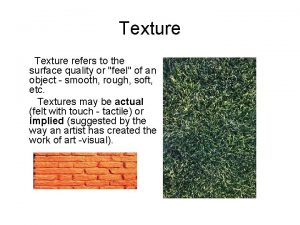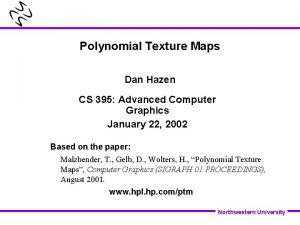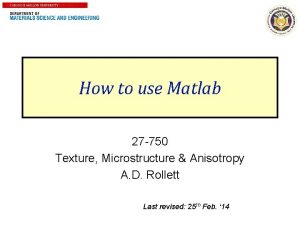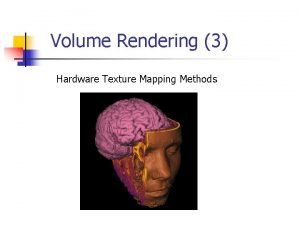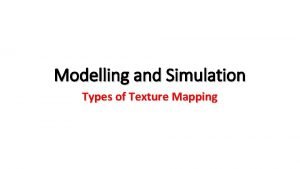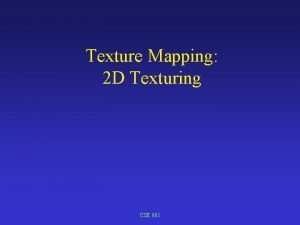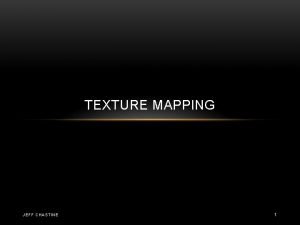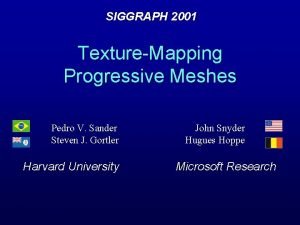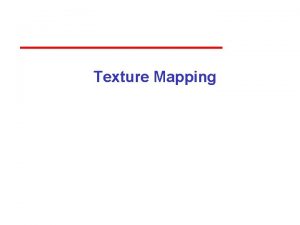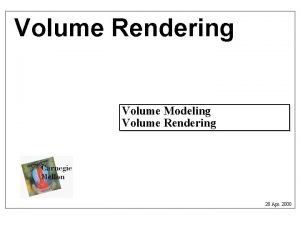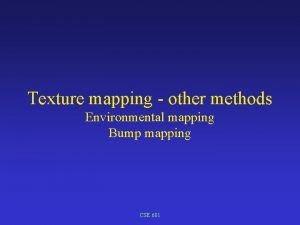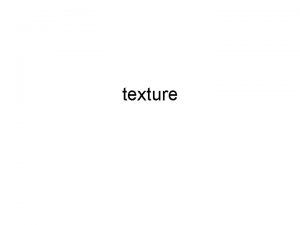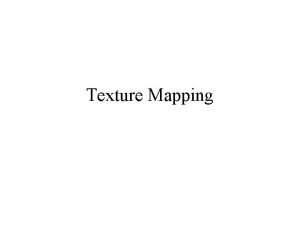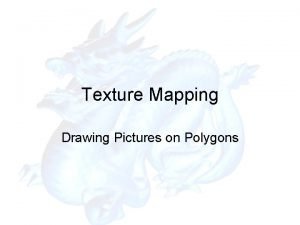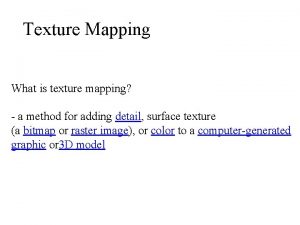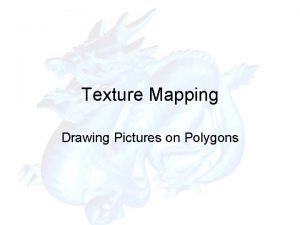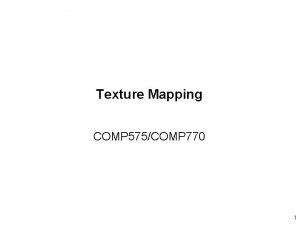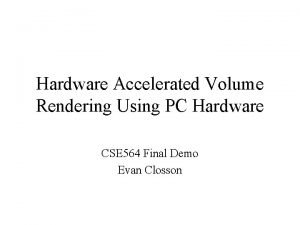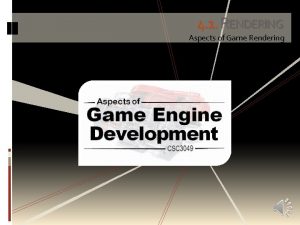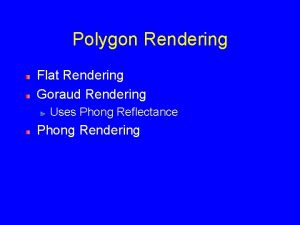Volume Rendering 3 Hardware Texture Mapping Methods Texture

















- Slides: 17

Volume Rendering (3) Hardware Texture Mapping Methods

Texture Mapping + 2 D image 2 D polygon Textured-mapped polygon

Texture Mapping (2) (0, 1) (0, 0) (1, 1) (0, 0. 5) (0. 5, 0. 5) (0, 0) (0. 5, 0) (1, 0) Each texel has 2 D coordinates assigned to it. assign the texture coordinates to each polygon to establish the mapping

Tex. Mapping for Volume Rendering Remember ray casting … y z

Texture based volume rendering z y x • Render each xz slice in the volume as a texture-mapped polygon • The texture contains RGBA (color and opacity) • The polygons are drawn from back to front

Texture based volume rendering Algorithm: (using 2 D texture mapping hardware) Turn off the z-buffer; Enable blending For (each slice from back to front) { - Load the 2 D slice of data into texture memory - Create a polygon corresponding to the slice - Assign texture coordinates to four corners of the polygon - Render and composite the polygon (use Open. GL alpha blending) }

Some Considerations… (2) What if we change the viewing position? y z That is okay, we just change the eye position (or rotate the polygons and re-render), Until …

Some Considerations… (3) Until … You are not going to see anything this way … This is because the view direction now is Parallel to the slice planes What do we do? y z

Some Considerations… (4) What do we do? • Change the orientation of slicing planes • Now the slice polygons are parallel to XZ plane in the object space • We need to reorganize the input textures y z • Reorganize the textures on the fly is too time consuming. We might want to prepare this texture sets beforehand

Some Considerations… (5) When do we need to change the slicing planes? y z ? When the major component of view vector changes from z to y

Some Considerations… (6) Major component of view vector? Normalized view vector (x, y, z) -> get the maximum one If x: then the slicing planes are parallel to yz plane If y: then the slicing planes are parallel to xz plane If z: then the slicing planes are parallel to xy plane -> This is called (object-space) axis-aligned method. Therefore, we need to keep three copies of data around all the time!!

Problem Object-space axis-alighed method can create artifact: Poping Effect y z V = 44. 999 V = 45. 0001 There is a sudden change of viewing slicing (and thus the sampling rate) then the view vector transits from one major direction to another. The change in the result image intensity can be quite visible

Solution Use Image-space axis-aligned slicing plane: the slicing planes are always parallel to the view plane

Image-Space Axis-Aligned Arbitrary slicing through the volume and texture mapping capabilities are needed - Arbitrary slicing: this can be computed using software in real time This is basically polygon-volume clipping

Image-Space Axis-Aligned (2) Texture mapping to the arbitrary slices This requires 3 D Solid texture mapping Input texture: A bunch of slices (volume) Depending on the position of the polygon, appropriate textures are mapped to the polygon.

Solid (3 D) Texture Mapping Now the input texture space is 3 D (0, 1, 1) (1, 1, 1) (0, 1, 0) Texture coordinates (r, s) -> (r, s, t) (1, 1, 0) (r 2, s 2, t 2) (0, 0, 0) (r 3, s 3, t 3) (1, 0, 0) (r 0, s 0, t 0) (r 1, s 1, t 1)

Pros and Cons Advantages: - Higher quality - No popping effect Disadvantages: - Need to compute the slicing planes for every view angle - 3 D texture mapping is not supported by most of graphics hardware except high end ones (althugh people are working on it right now. ATI Radeon card, $250, starts to support it. Both 2 D or 3 D hardware texture mapping methods can not compute Shading on the fly. The input textures have to be pre-shaded.
 Icc rendering intent to wcs gamut mapping
Icc rendering intent to wcs gamut mapping Jerry tessendorf
Jerry tessendorf Introduction to volume rendering
Introduction to volume rendering Indirect volume rendering
Indirect volume rendering Raycasting dda
Raycasting dda Renderer
Renderer You can touch and feel an implied texture
You can touch and feel an implied texture External components of computer
External components of computer Northwestern university
Northwestern university Matlab texture mapping
Matlab texture mapping Texture mapping algorithm
Texture mapping algorithm Texture mapping types
Texture mapping types 2d texture mapping
2d texture mapping Summed area table
Summed area table Jeff chastine
Jeff chastine Texture mapping progressive meshes
Texture mapping progressive meshes The associative mapping is costlier than direct mapping.
The associative mapping is costlier than direct mapping. Forward mapping vs backward mapping
Forward mapping vs backward mapping

